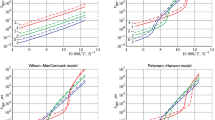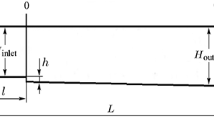Abstract
A possibility of using some kinetic models for the description of detonation of a gaseous hydrogen–air mixture is justified. A hierarchy of mathematical models from the simplest model of combustion under static conditions to the model of unsteady nonequilibrium gas dynamics is numerically constructed. Verification is performed on the basis of experimental data on the ignition delay time as a function of temperature and on the detonation wave velocity as a function of dilution of the mixture by argon or nitrogen. A mathematical technology for the description of cellular detonation propagation in channels of various engineering devices is developed on the basis of detailed and reduced kinetic mechanisms of nonequilibrium chemical transformations within the framework of the ANSYS Fluent commercial software system. It is demonstrated that the cell size in a mixture diluted by argon by 92% in a channel 30 mm wide is in good agreement with experimental data.
Similar content being viewed by others

References
A. V. Fedorov, D. A. Tropin, and I. A. Bedarev, “Mathematical Modeling of Detonation Suppression in a Hydrogen–Oxygen Mixture by Inert Particles,” Fiz. Goreniya Vzryva 46 (3), 103–115 (2010) [Combust., Expl., Shock Waves 46 (3), 332–343 (2010)].
V. P. Korobeinikov and V. A. Levin, “Strong Explosion in a Combustible Gas Mixture,” Izv. Akad. Nauk SSSR, Mekh. Zhidk. Gaza, No. 6, 48–51 (1969).
Yu. A. Nikolaev and D. V. Zak, “Agreement of Models of Chemical Reactions in Gases with the Second Law of Thermodynamics,” Fiz. Goreniya Vzryva 24 (4), 87–90 (1988) [Combust., Expl., Shock Waves 24 (4), 461–463 (1988)].
Yu. A. Nikolaev and P. A. Fomin, “Analysis of Equilibrium Flows of Chemically Reacting Gases,” Fiz. Goreniya Vzryva 18 (1), 66–72 (1982) [Combust., Expl., Shock Waves 18 (1), 53–58 (1982)].
V. I. Dimitrov, Simple Kinetics (Nauka, Novosibirsk, 1982) [in Russian].
Chung K. Law, Combustion Physics (Cambridge Univ. Press, 2006).
I. A. Bedarev and A. V. Fedorov, “Comparative Analysis of Three Mathematical Models of Hydrogen Ignition,” Fiz. Goreniya Vzryva 42 (1), 26–33 (2006) [Combust., Expl., Shock Waves 42 (1), 19–26 (2006)].
J. H. Tien and R. J. Stalker, “Release of Chemical Energy by Combustion in a Supersonic Mixing Layer of Hydrogen and Air,” Combust. Flame 131 (3), 329–348 (2002).
N. G. Dautov and A. M. Starik, “On Choosing the Kinetic Scheme for the Description of Detonation in the H2+Air Mixture behind Shock Waves,” Teplofiz. Vys. Temp. 31 (2), 292–301 (1993).
Y. Hidaka, K. Sato, Y. Henmi, H. Tanaka, and K. Inami, “Shock-Tube and Modeling Study of Methane Pyrolysis and Oxidation,” Combust. Flame 118 (3), 340–358 (1999).
G. L. Schott and J. L. Kinsey, “Kinetic Studies of Hydroxyl Radicals in Shock Waves. II. Induction Times in the Hydrogen–Oxygen Reactions,” J. Chem. Phys., No. 29, 1177–1188 (1958).
E. L. Petersen, D. M. Kalitan, and M. J. A. Rickard, “Chemical Kinetics of OH* Chemiluminescence in High-Temperature Reacting Flows,” in Proc. of the Third Joint Meeting of the U. S. Sections of the Combustion Institute Chicago, Illinois, USA (2003), Papers C25/PL05.
R. K. Cheng and A. K. Oppenheim, “Autoignition in Methane–Hydrogen Mixtures,” Combust. Flame 58 (2), 125–139 (1984).
R. Blumenthal, K. Fieweger, K. H. Komp, G. Adomeit, and B. E. Gelfand, “Self-Ignition of H2/Air Mixtures at High Pressure and Low Temperature,” in Proc. of the 20th Inter. Symp. on Shock Waves (1995, pp. 935–940).
R. Blumenthal, “Experimentelle Untersuchung und numerische Simulation der Selbstzündung von Kraftstoff/Luft-Gemischen im Stoßwellenrohr unter Berücksichtigung Strömungsmechanischer,” Doctoral Thesis, Einflüsse, Inst. für Allgemeine Mechanik, RWTH Aachen (1996).
M. W. Slack, “Rate Coefficient for H + O2 + M = HO2 + M Evaluated from Shock Tube Measurements of Induction Times,” Combust. Flame 28, 241–249 (1977).
K. A. Bhaskaran, M. C. Gupta, and Th. Just, “Shock Tube Study of the Effect of Unsymmetric Dimethyl Hydrazine on the Ignition Characteristics of Hydrogen–Air Mixtures,” Combust. Flame 21 (1), 45–48 (1973).
M. Slack and A. Grillo, “Investigation of Hydrogen–Air Ignition Sensitized by Nitric Oxide and by Nitrogen Dioxide,” NASACR-2896 (1977).
R. Akbar, “Mach Reflection of Gaseous Detonations,” Ph.D. Thesis (Rensselaer Polytechnic Inst., New York, USA, 1997).
E. Schultz and J. Shepherd, “Validation of Detailed Reaction Mechanisms for Detonation Simulation,” Graduate Aeronaut. Lab. California Inst. of Technol. Pasadena, CA 91125 (February 8, 2000).
B. Lewis and G. von Elbe, Combustion, Flame, and Explosions of Gases (New York, 1961).
W. Fickett and W. W. Wood, “Flow Calculations for Pulsating One-Dimensional Detonations,” Phys. Fluids 9 (5), (1966).
S. A. Medvedev, “Attenuation of Overdriven Detonation Waves with a Finite Reaction Rate,” Mekh. Zhidk. Gaza, No. 3 (1969).
V. A. Levin and V. V. Markov, “Initiation of Detonation by Concentrated Release of Energy,” Fiz. Goreniya Vzryva 11 (4), 623–633 (1975) [Combust., Expl., Shock Waves 11 (4), 529–536 (1975)].
I. A. Bedarev and A. V. Fedorov, “Testing the Method of Adaptive Grids on Calculations of One-Dimensional Detonation Waves,” Vychisl. Tekhnol. 14 (3), 14–24 (2009).
E. S. Oran, J. W. Weber, E. I. Stefaniw, M. H. Lefebvre, and J. D. Anderson, “A Numerical Study of a Two-Dimensional H2–O2–Ar Detonation Using a Detailed Chemical Reaction Model,” Combust. Flame 113 (1-2), 147–163 (1998).
A. V. Trotsyuk, “Numerical Simulation of the Structure of Two-Dimensional Gaseous Detonation of an H2–O2–Ar Mixture,” Fiz. Goreniya Vzryva 35 (5), 93–103 (1999) [Combust., Expl., Shock Waves 35 (5), 549–558 (1999)].
R. A. Strehlow, R. Liangminas, R. H. Watson, and J. R. Eyman, “Transverse Wave Structure in Detonations,” in 11th Symp. Int. Combust. Proc. (1967), pp. 683–692.
Author information
Authors and Affiliations
Corresponding author
Additional information
Original Russian Text © I.A. Bedarev, K.V. Rylova, A.V. Fedorov.
Published in Fizika Goreniya i Vzryva, Vol. 51, No. 5, pp. 22–33, September–October, 2015.
Original article submitted May 23, 2014.
Rights and permissions
About this article
Cite this article
Bedarev, I.A., Rylova, K.V. & Fedorov, A.V. Application of detailed and reduced kinetic schemes for the description of detonation of diluted hydrogen–air mixtures. Combust Explos Shock Waves 51, 528–539 (2015). https://doi.org/10.1134/S0010508215050032
Received:
Published:
Issue Date:
DOI: https://doi.org/10.1134/S0010508215050032



